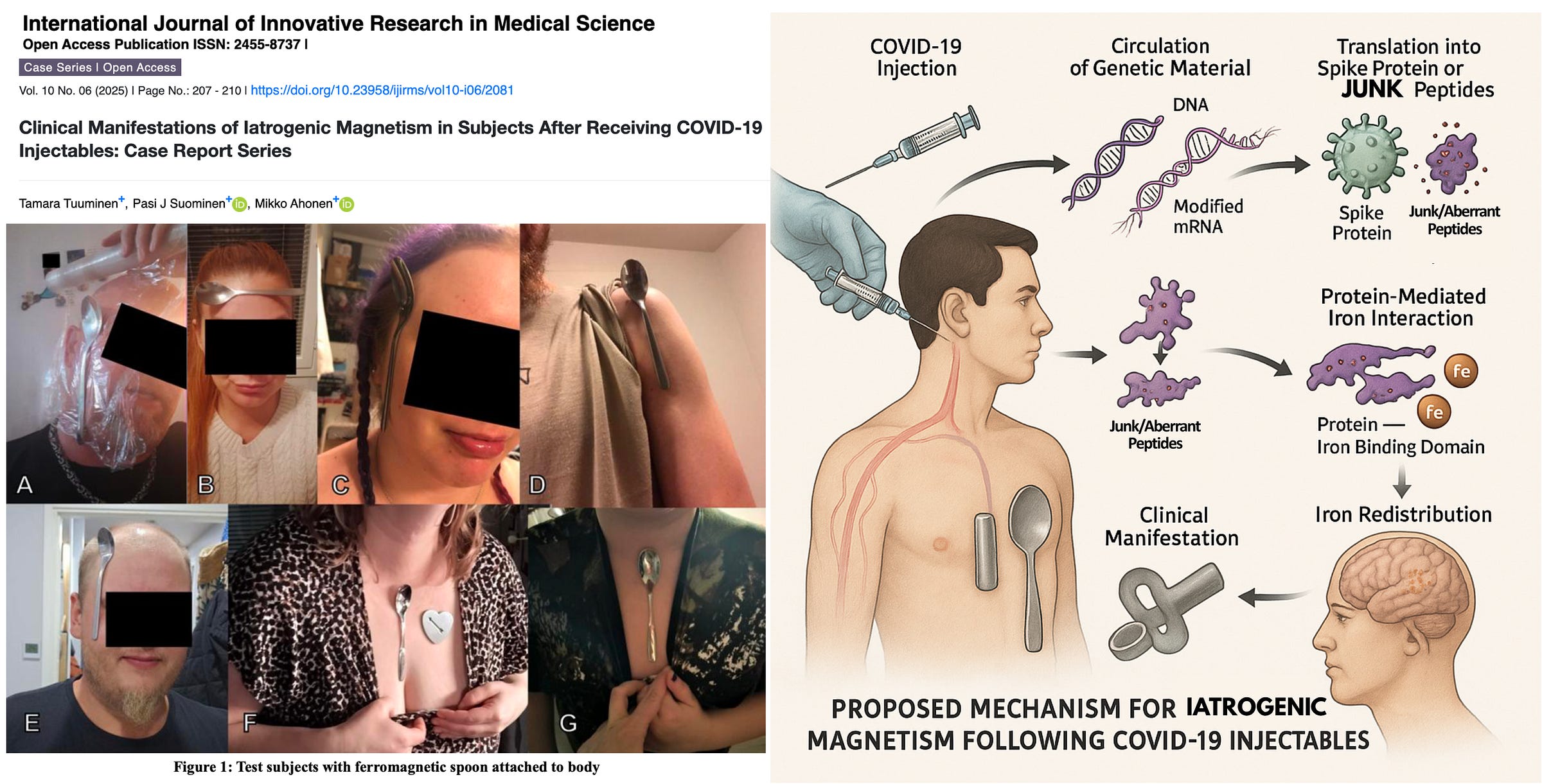 By Independent News Roundup
By Independent News Roundup
The study titled, Clinical Manifestations of Iatrogenic Magnetism in Subjects After Receiving COVID-19 Injectables: Case Report Series, was just published in the International Journal of Innovative Research in Medical Science:
Abstract
A series of cases of COVID-19 vaccine-injected patients suffering from iatrogenic magnetism is described. The attachment of massive metallic objects (up to 70 grams) to different parts of the body is a real phenomenon that may present additional health risks if such patients are subjected to magnetic resonance imaging (MRI). The iatrogenic magnetism phenomenon typically appears several months after the injection. More likely, injected DNA plasmids, or modified mRNAs, translated into the spike protein, or into junk peptides formed through frameshifts, may engender proteins with ferromagnetic properties, or may entrap endogenous iron. Importantly, the spike protein has a distant homology to hepcidin, the key regulator of iron metabolism. Redistribution of iron into the brain or other body parts may be causing iatrogenic magnetism. Pfizer vaccine lots starting with the letter “F” may be involved, although we cannot exclude the possibility that Moderna or other manufacturers’ injections may also cause this phenomenon. In our observation, the magnetism may resolve spontaneously or when nicotinamide adenine dinucleotide (NAD+) is applied. Our pilot observation needs to be corroborated in a larger cohort study.

This study has confirmed observations reported by many individuals since 2021. Let’s break down what the researchers found:
Case 1:
A
53-year-old male with no prior magnetism developed magnetic adhesion of
a 25g object to both temples about 15 months after receiving two Pfizer
injections (lots EY3014 and FE3065). He experienced chest pain,
arrhythmia, full-body tremors, cognitive impairment, and other systemic
symptoms.
Case 2:
A previously
healthy 39-year-old female developed magnetism in her forehead and right
shoulder—at the injection site—around one month after receiving a
single Pfizer dose (lot FL4574). A 42g metal object adhered to her
forehead, causing pain; symptoms lessened with alcohol and intensified
during grounding.
Case 3:
A
28-year-old female developed magnetism approximately 20 months after
receiving two Pfizer injections (lots FE2296 and FH0161). A 45g metal
object adhered to her forehead, temple, and chest, but the magnetism
faded over time, possibly due to self-initiated NAD⁺ therapy (500
mg/day).
Case 4:
A 28-year-old
male reported magnetism of a 42g metal object to his left temple and
ribcage around 20 months post-injection with both Pfizer (lot FH9951)
and Moderna (lot 3004494). Cognitive symptoms and visual disturbances
during MRI resolved with NAD⁺, but relapsed after discontinuation.
Case 5:
A
32-year-old previously healthy male—spouse of Case 2—developed
magnetism two months after receiving the Pfizer vaccine (lot FL4574). A
70g metal object adhered to his forehead, chest, and shoulder opposite
the injection site, with no improvement from food or medication.
Case 6:
A
36-year-old female developed strong magnetism (~25g object adherence to
her sternum) one month after receiving Pfizer and Moderna vaccines
(lots 1F1012A and 3006274). Her unvaccinated 10-year-old son also
developed similar chest-localized magnetism, raising the possibility of
vaccine-related shedding.
The authors concluded:
“The phenomenon of magnetism is real and not a nocebo effect.”
However, it’s important to also consider a study by Thorp et al titled, Unexpected magnetic attraction: Evidence for an organized energy field in the human body:
Introduction & Background: In recent months unexpected reports have surfaced claiming the presence of magnetic attraction in the shoulder regions of subjects who had recently received the COVID-19 vaccination. Purpose: To determine if such claims are legitimate or spurious.
Methods: A prospective observational study was performed utilizing standard neodymium magnets and non-magnetized paper clips in a rigorously standardized application protocol. Magnets and paper clips were applied over various regions of both deltoid muscles. The attraction score was calculated by adding one point for each pole of the magnet that attached to each arm over the deltoid muscle for a maximum score of 4. Likewise, three sizes of paper clips were tested with a maximum score of 6. The field score was calculated by adding the magnet score to the paper clip score for a maximum score of 10 points.
Results: 256 subjects were enrolled from June 1-July 7, 2021. Of these subjects, 148 (57.8%) declined the COVID-19 vaccination and 108 (42.2%) received it. Comparison of the two groups showed no significant differences with the magnet score, the clip score, or the total magnetic score (P > 0.1). Multiple regression models used all relevant dependent and independent variables and only autoimmune disease was associated with a reduced field score (p = 0.01).
Conclusions: A strong magnetic field is generated in the human body that has no causal relation to previous COVID-19 vaccination.
Further investigation is required to reach a definitive conclusion regarding COVID-19 mRNA injections and magnetism.
Epidemiologist and Foundation Administrator, McCullough Foundation
www.mcculloughfnd.org
